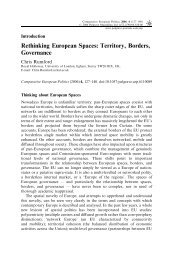Europeanisation, National Identities and Migration ... - europeanization
Europeanisation, National Identities and Migration ... - europeanization
Europeanisation, National Identities and Migration ... - europeanization
Create successful ePaper yourself
Turn your PDF publications into a flip-book with our unique Google optimized e-Paper software.
German trade unions <strong>and</strong> Polish migrant workers 195<br />
the GDR, the number of construction workers was above the Western average.<br />
After 1990, the East German construction industry grew by 125 per cent up to<br />
1995, <strong>and</strong> by 1998, it formed 15 per cent of the total Gross <strong>National</strong> Product<br />
of East Germany (which is three times as much as in West Germany <strong>and</strong><br />
indicates both the volume of investment in construction <strong>and</strong> the weakness<br />
of other industries in the eastern part of the country). Employment had grown<br />
by 43 per cent (Syben 1998: 14). One reason for rising unemployment in the<br />
second half of the 1990s thus derived from a previous oversupply of labour<br />
(Treichler 1998: 234).<br />
5 Additionally, the influx of immigrants (ethnic Germans, foreigners, asylum<br />
seekers) contributed to the increase in labour supply <strong>and</strong> unemployment in<br />
this sector. A disproportionate number of those with rights of access to the<br />
German labour markets look for employment in construction. While in 1987,<br />
about 20 per cent of all those who became unemployed from the construction<br />
industry had not worked in Germany before, the share grew to 37 per cent in<br />
1992. The increase in unemployment mirrors not so much the replacement<br />
of already-employed resident workers, but an increased presence of immigrants<br />
to the unemployment rolls: ‘By no means the contract for services workers<br />
can be blamed for this increase’ (IW 1993: 21).<br />
6 The German government has since 1989 signed bi-lateral agreements with<br />
twelve Central <strong>and</strong> East European (CEE) countries on the employment of East<br />
European contract workers. These inter-governmental agreements gave<br />
large German enterprises the opportunity to cooperate with subcontractors<br />
from CEE-countries (Rudolph 1996). Within a fixed limit of initially nearly<br />
100,000 workers, East European contract enterprises gained access to German<br />
labour markets. The CEE-firms competed for work with the German small<strong>and</strong><br />
medium-sized enterprises. The foreign sending-firm was under a duty<br />
to pay the workers according to the German st<strong>and</strong>ards. However, employment<br />
took place mostly with disregard to the statutory conditions (cf. Cyrus <strong>and</strong><br />
Helias 1993; Bundesregierung 1996; Faist et al. 1999). Pol<strong>and</strong> holds the greatest<br />
share of the contract for services programme, with a limit of 35,170 workers<br />
(cf. Cyrus 1994, 2001b).<br />
7 With the completion of the European Single Market in 1993, providing for<br />
free movement of workers <strong>and</strong> service enterprises within the EU, construction<br />
firms <strong>and</strong> workers from other EU member states gained free access to the<br />
German construction market. Consequently the number of EU enterprises <strong>and</strong><br />
the number of workers from other EU member states increased. Sending enterprises<br />
from EU member states signed subcontracts with German construction<br />
enterprises <strong>and</strong> thus competed with the CEE-contract firms <strong>and</strong> the German<br />
small- <strong>and</strong> medium-sized firms. The numbers of EU contract workers quickly<br />
amounted to an estimated 200,000 workers (Köbele <strong>and</strong> Leuschner 1995).<br />
In a speech to a trade union conference, the Minister for Labour <strong>and</strong> Social<br />
Order, Norbert Blüm (1995) underlined that, in spite of an economic boom in<br />
construction, 134,000 resident construction workers were unemployed, while<br />
at the same time, 150,000 legal EU workers were employed (Blüm 1995: 129).



